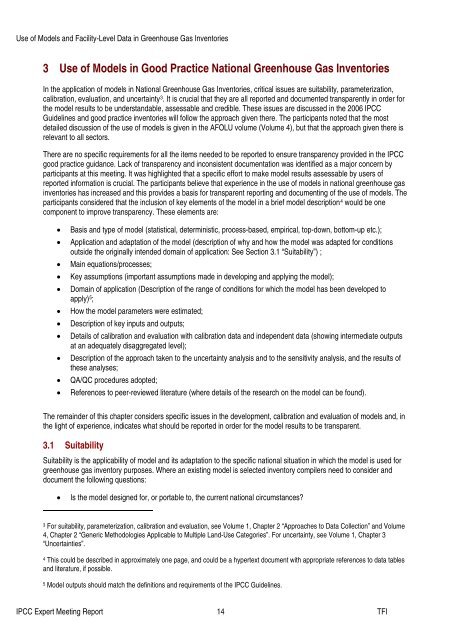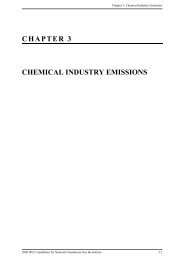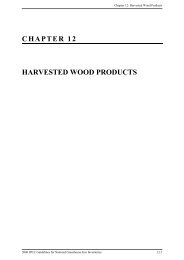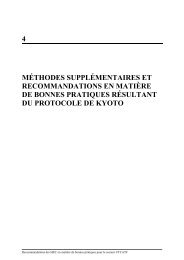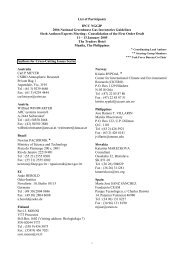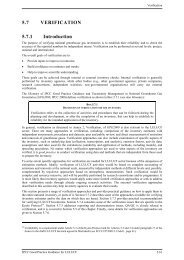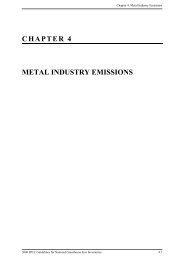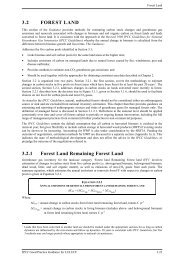Use of Models and Facility-Level Data in Greenhouse Gas Inventories
Use of Models and Facility-Level Data in Greenhouse Gas Inventories
Use of Models and Facility-Level Data in Greenhouse Gas Inventories
You also want an ePaper? Increase the reach of your titles
YUMPU automatically turns print PDFs into web optimized ePapers that Google loves.
<strong>Use</strong> <strong>of</strong> <strong>Models</strong> <strong>and</strong> <strong>Facility</strong>-<strong>Level</strong> <strong>Data</strong> <strong>in</strong> <strong>Greenhouse</strong> <strong>Gas</strong> <strong>Inventories</strong><br />
3 <strong>Use</strong> <strong>of</strong> <strong>Models</strong> <strong>in</strong> Good Practice National <strong>Greenhouse</strong> <strong>Gas</strong> <strong>Inventories</strong><br />
In the application <strong>of</strong> models <strong>in</strong> National <strong>Greenhouse</strong> <strong>Gas</strong> <strong>Inventories</strong>, critical issues are suitability, parameterization,<br />
calibration, evaluation, <strong>and</strong> uncerta<strong>in</strong>ty 3 . It is crucial that they are all reported <strong>and</strong> documented transparently <strong>in</strong> order for<br />
the model results to be underst<strong>and</strong>able, assessable <strong>and</strong> credible. These issues are discussed <strong>in</strong> the 2006 IPCC<br />
Guidel<strong>in</strong>es <strong>and</strong> good practice <strong>in</strong>ventories will follow the approach given there. The participants noted that the most<br />
detailed discussion <strong>of</strong> the use <strong>of</strong> models is given <strong>in</strong> the AFOLU volume (Volume 4), but that the approach given there is<br />
relevant to all sectors.<br />
There are no specific requirements for all the items needed to be reported to ensure transparency provided <strong>in</strong> the IPCC<br />
good practice guidance. Lack <strong>of</strong> transparency <strong>and</strong> <strong>in</strong>consistent documentation was identified as a major concern by<br />
participants at this meet<strong>in</strong>g. It was highlighted that a specific effort to make model results assessable by users <strong>of</strong><br />
reported <strong>in</strong>formation is crucial. The participants believe that experience <strong>in</strong> the use <strong>of</strong> models <strong>in</strong> national greenhouse gas<br />
<strong>in</strong>ventories has <strong>in</strong>creased <strong>and</strong> this provides a basis for transparent report<strong>in</strong>g <strong>and</strong> document<strong>in</strong>g <strong>of</strong> the use <strong>of</strong> models. The<br />
participants considered that the <strong>in</strong>clusion <strong>of</strong> key elements <strong>of</strong> the model <strong>in</strong> a brief model description<br />
4<br />
would be one<br />
component to improve transparency. These elements are:<br />
• Basis <strong>and</strong> type <strong>of</strong> model (statistical, determ<strong>in</strong>istic, process-based, empirical, top-down, bottom-up etc.);<br />
• Application <strong>and</strong> adaptation <strong>of</strong> the model (description <strong>of</strong> why <strong>and</strong> how the model was adapted for conditions<br />
outside the orig<strong>in</strong>ally <strong>in</strong>tended doma<strong>in</strong> <strong>of</strong> application: See Section 3.1 “Suitability”) ;<br />
• Ma<strong>in</strong> equations/processes;<br />
• Key assumptions (important assumptions made <strong>in</strong> develop<strong>in</strong>g <strong>and</strong> apply<strong>in</strong>g the model);<br />
• Doma<strong>in</strong> <strong>of</strong> application (Description <strong>of</strong> the range <strong>of</strong> conditions for which the model has been developed to<br />
apply) 5 ;<br />
• How the model parameters were estimated;<br />
• Description <strong>of</strong> key <strong>in</strong>puts <strong>and</strong> outputs;<br />
• Details <strong>of</strong> calibration <strong>and</strong> evaluation with calibration data <strong>and</strong> <strong>in</strong>dependent data (show<strong>in</strong>g <strong>in</strong>termediate outputs<br />
at an adequately disaggregated level);<br />
• Description <strong>of</strong> the approach taken to the uncerta<strong>in</strong>ty analysis <strong>and</strong> to the sensitivity analysis, <strong>and</strong> the results <strong>of</strong><br />
these analyses;<br />
• QA/QC procedures adopted;<br />
• References to peer-reviewed literature (where details <strong>of</strong> the research on the model can be found).<br />
The rema<strong>in</strong>der <strong>of</strong> this chapter considers specific issues <strong>in</strong> the development, calibration <strong>and</strong> evaluation <strong>of</strong> models <strong>and</strong>, <strong>in</strong><br />
the light <strong>of</strong> experience, <strong>in</strong>dicates what should be reported <strong>in</strong> order for the model results to be transparent.<br />
3.1 Suitability<br />
Suitability is the applicability <strong>of</strong> model <strong>and</strong> its adaptation to the specific national situation <strong>in</strong> which the model is used for<br />
greenhouse gas <strong>in</strong>ventory purposes. Where an exist<strong>in</strong>g model is selected <strong>in</strong>ventory compilers need to consider <strong>and</strong><br />
document the follow<strong>in</strong>g questions:<br />
• Is the model designed for, or portable to, the current national circumstances?<br />
3 For suitability, parameterization, calibration <strong>and</strong> evaluation, see Volume 1, Chapter 2 “Approaches to <strong>Data</strong> Collection” <strong>and</strong> Volume<br />
4, Chapter 2 “Generic Methodologies Applicable to Multiple L<strong>and</strong>-<strong>Use</strong> Categories”. For uncerta<strong>in</strong>ty, see Volume 1, Chapter 3<br />
“Uncerta<strong>in</strong>ties”.<br />
4 This could be described <strong>in</strong> approximately one page, <strong>and</strong> could be a hypertext document with appropriate references to data tables<br />
<strong>and</strong> literature, if possible.<br />
5 Model outputs should match the def<strong>in</strong>itions <strong>and</strong> requirements <strong>of</strong> the IPCC Guidel<strong>in</strong>es.<br />
IPCC Expert Meet<strong>in</strong>g Report 14 TFI


